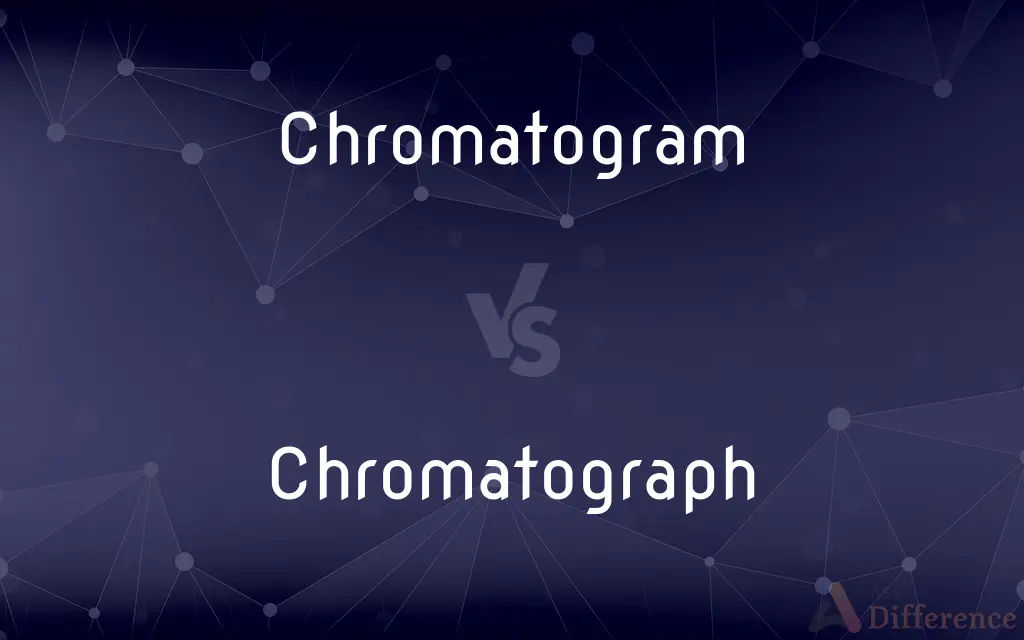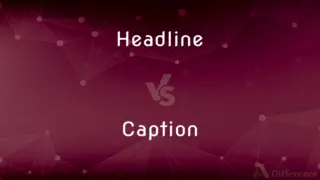Chromatogram vs. Chromatograph — What's the Difference?
By Tayyaba Rehman — Updated on October 30, 2023
A chromatogram is the visual output showing separated components, while a chromatograph is the equipment used to perform chromatography.

Difference Between Chromatogram and Chromatograph
Table of Contents
ADVERTISEMENT
Key Differences
A chromatogram serves as the graphical representation that displays the result of the chromatography process. It visually depicts the separated components as peaks on a graph, with each peak corresponding to a specific substance. On the contrary, a chromatograph is the actual physical device or equipment utilized to carry out the chromatography technique, separating mixtures into their individual parts.
While the chromatogram is essential for scientists to interpret and identify the separated components of a mixture, the chromatograph is indispensable in physically separating these components. The intensity and position of peaks in a chromatogram provide vital information about the quantity and identity of components in a sample.
In the laboratory, a researcher might use a chromatograph to analyze a sample. After the separation process is completed, they would study the chromatogram, which is produced as an outcome of the procedure, to identify and quantify the substances present.
From a linguistic perspective, "chromatogram" centers on the "result" of the process, whereas "chromatograph" emphasizes the "tool" or "machine" used for the separation.
Comparison Chart
Basic Definition
Graphical representation of separated components.
Equipment or machine used for chromatography.
ADVERTISEMENT
Nature
Resultant product of chromatography.
Tool used to perform chromatography.
Utility
Used for interpretation and identification.
Used for physical separation of components.
Association
Peaks, separation result.
Separation technique, device.
Linguistic Context
Focuses on the "result" of the process.
Emphasizes the "tool" or "machine" used for the process.
Compare with Definitions
Chromatogram
A graphical output of chromatography.
The chromatogram displayed distinct peaks for each component.
Chromatograph
A machine that produces chromatograms.
The chromatograph provided a clear chromatogram of the sample.
Chromatogram
An output showing the retention times of components.
The chromatogram indicated the retention time for each chemical.
Chromatograph
An apparatus for separating and identifying component substances.
With the help of the chromatograph, the unknown substance was identified.
Chromatogram
A record of the separated substances.
By analyzing the chromatogram, they could identify the substances present.
Chromatograph
A device for separating mixtures.
Using the chromatograph, they separated the mixture into its individual compounds.
Chromatogram
A visual representation of component separation.
Each peak on the chromatogram corresponds to a different compound.
Chromatograph
An instrument for performing chromatography.
The laboratory was equipped with a state-of-the-art chromatograph.
Chromatogram
A plot showing the intensity of detection versus retention time.
The height of the peaks in the chromatogram showed the abundance of each compound.
Chromatograph
Equipment used to analyze complex samples.
The scientist used the chromatograph to analyze the environmental samples.
Chromatogram
The pattern of separated substances obtained by chromatography.
Chromatograph
An instrument that produces a chromatogram.
Chromatogram
(analytical chemistry) The visual output from a chromatograph. Usually a graphical display or histogram.
Chromatograph
To separate and analyze by chromatography.
Chromatogram
The paper strip, column, gel, or TLC plate on which subsances have been separated by a process of chromatography{2}.
Chromatograph
(analytical chemistry) A machine that performs chromatography by gas or liquid separation.
Chromatogram
The record of the results of a process of chromatography{2}, produced by an instrument which measures some property related to the concentration of substances over the course of a chromatographic process. The record may be printed, for example, on a piece of paper, showing the concentration of some substance as a function of time or volume; or it may be retained in a computer and displayed on a video display terminal.
Chromatograph
To analyze or separate mixtures using chromatography
Chromatogram
The recording (column or paper strip) on which the constituents of a mixture are adsorbed in chromatography
Chromatograph
A piece of equipment used to perform chromatography{2}.
Common Curiosities
Is a chromatograph the same as chromatography?
No, a chromatograph is the equipment used, while chromatography is the separation technique itself.
What is the primary function of a chromatograph?
A chromatograph's main function is to separate mixtures into individual components.
Can a chromatogram show the quantity of substances?
Yes, the intensity of peaks in a chromatogram can indicate the quantity of specific substances.
What does a chromatogram represent?
A chromatogram represents the visual result of chromatography, showing separated components as peaks.
Is the chromatogram the final step in chromatography?
The chromatogram is the output or result of chromatography, used for analysis and interpretation.
Is the data in a chromatogram qualitative or quantitative?
A chromatogram provides both qualitative (identity) and quantitative (amount) information about components.
Can any machine produce a chromatogram?
No, only machines designed for chromatography, like chromatographs, produce chromatograms.
Do all chromatographs produce similar chromatograms?
No, chromatograms can vary based on the sample and the type of chromatography used.
Which is more expensive, the chromatogram or the chromatograph?
The chromatograph, being a physical piece of equipment, is typically more expensive than producing a chromatogram.
Can chromatographs handle complex mixtures?
Yes, chromatographs are designed to analyze and separate complex mixtures.
Why is the chromatogram important in labs?
Chromatograms are vital for interpreting and identifying separated components of a mixture.
Why are there peaks in a chromatogram?
Peaks represent separated components, with the height indicating quantity and position indicating retention time.
How long does it take a chromatograph to produce a chromatogram?
The time varies based on the sample and chromatography type but can range from minutes to hours.
How is the efficiency of a chromatograph determined?
Efficiency can be determined by its ability to separate and resolve complex mixtures, producing clear chromatograms.
Share Your Discovery

Previous Comparison
Sanitised vs. Sanitized
Next Comparison
Headline vs. CaptionAuthor Spotlight
Written by
Tayyaba RehmanTayyaba Rehman is a distinguished writer, currently serving as a primary contributor to askdifference.com. As a researcher in semantics and etymology, Tayyaba's passion for the complexity of languages and their distinctions has found a perfect home on the platform. Tayyaba delves into the intricacies of language, distinguishing between commonly confused words and phrases, thereby providing clarity for readers worldwide.
















































